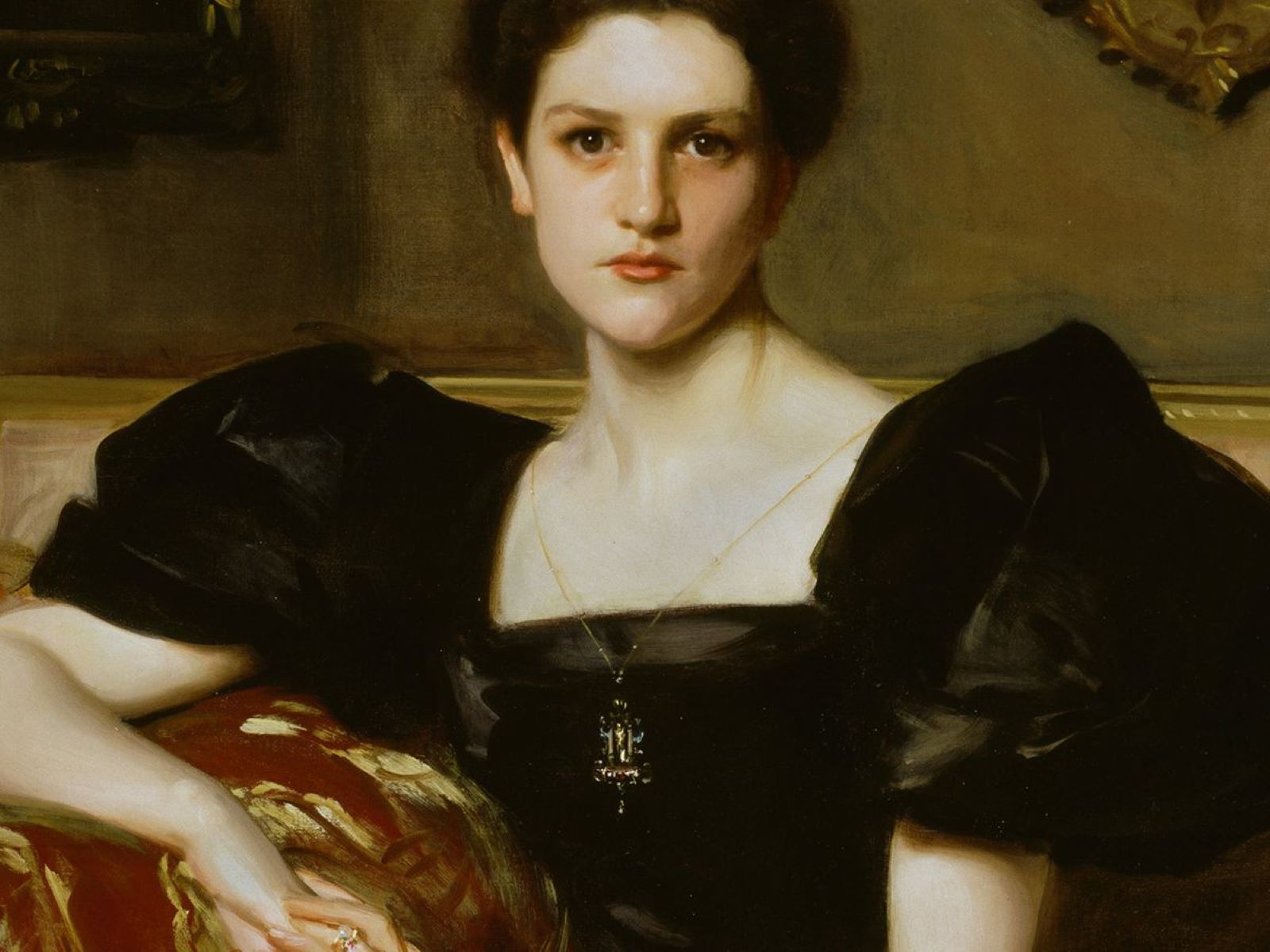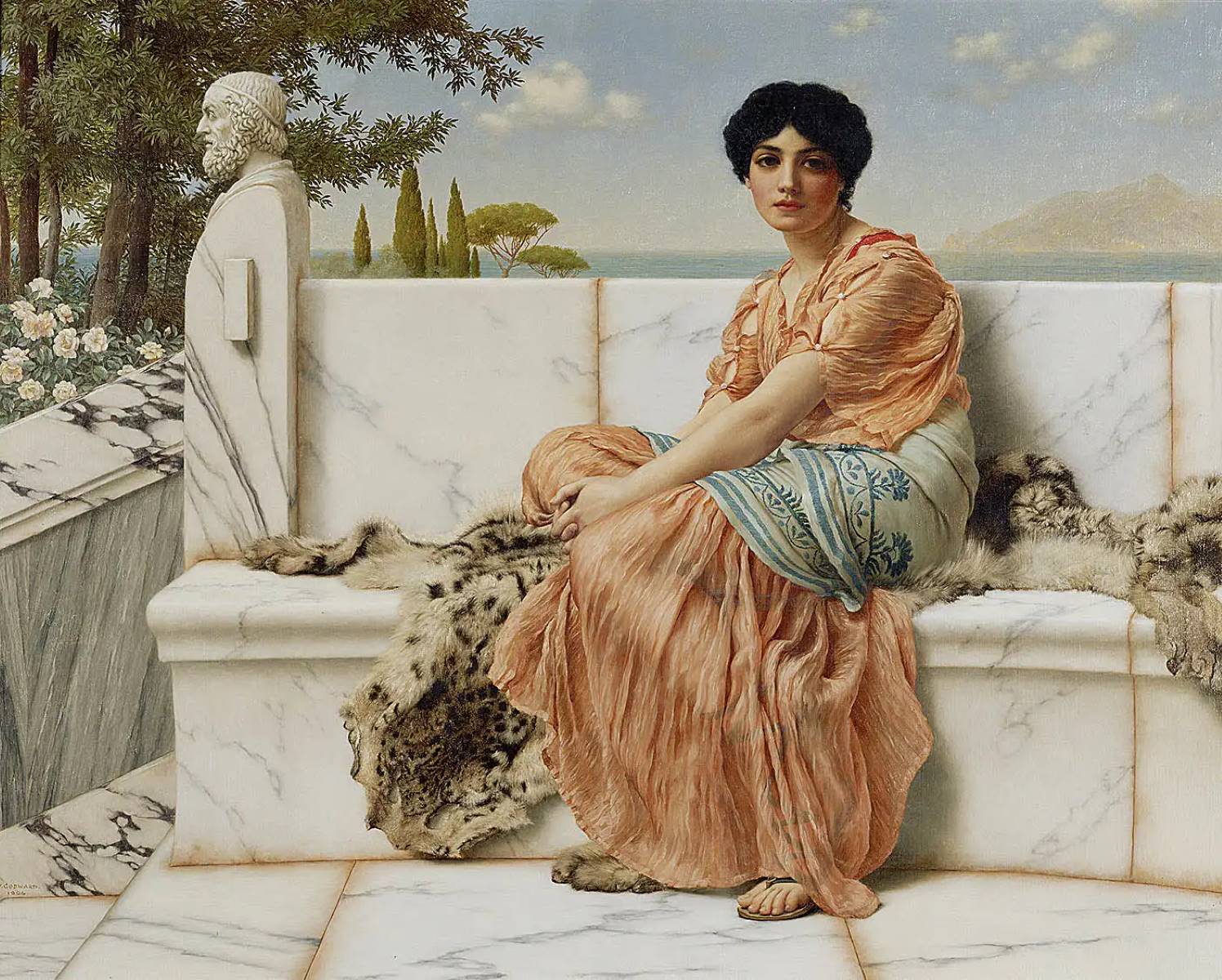Home>Arts and Culture>Top 10 Breathtaking Paintings Celebrating The Beauty Of Women


Arts and Culture
Top 10 Breathtaking Paintings Celebrating The Beauty Of Women
Published: January 23, 2024
Explore a stunning collection of paintings that celebrate the beauty of women in art and culture. Discover the top 10 breathtaking masterpieces that capture the essence of femininity.
(Many of the links in this article redirect to a specific reviewed product. Your purchase of these products through affiliate links helps to generate commission for Regretless.com, at no extra cost. Learn more)
Table of Contents
- Introduction
- Mona Lisa by Leonardo da Vinci
- The Birth of Venus by Sandro Botticelli
- Girl with a Pearl Earring by Johannes Vermeer
- Portrait of Adele Bloch-Bauer I by Gustav Klimt
- The Two Fridas by Frida Kahlo
- Lady with an Ermine by Leonardo da Vinci
- Olympia by Édouard Manet
- The Gypsy Girl by Frans Hals
- The Swing by Jean-Honoré Fragonard
- The Accolade by Edmund Blair Leighton
- Conclusion
Introduction
The portrayal of women in art has been a subject of fascination and admiration for centuries. Artists have captured the beauty, strength, and grace of women through their masterful brushstrokes, creating timeless masterpieces that continue to resonate with audiences around the world. From the enigmatic smile of the Mona Lisa to the ethereal charm of The Birth of Venus, these paintings celebrate the diverse facets of womanhood, inspiring awe and admiration in the hearts of beholders.
Throughout history, artists have sought to encapsulate the essence of femininity, often imbuing their works with symbolism, emotion, and cultural significance. These paintings not only showcase the physical allure of women but also convey their inner strength, resilience, and complexity. Each stroke of the brush serves as a testament to the profound impact of women on art, culture, and society as a whole.
Join us on a captivating journey through the annals of art history as we explore the top 10 breathtaking paintings that celebrate the beauty of women. From the enigmatic allure of the Mona Lisa by Leonardo da Vinci to the captivating gaze of the Girl with a Pearl Earring by Johannes Vermeer, these timeless masterpieces invite us to marvel at the enduring allure and enigmatic charm of women immortalized on canvas. Each painting offers a unique perspective, inviting viewers to delve into the rich tapestry of emotions, stories, and symbolism woven into the portrayal of women in art.
Embark on this enchanting odyssey as we unravel the stories behind these iconic paintings, delving into the artistic genius and cultural significance that have elevated these works to the pinnacle of artistic acclaim. Let us celebrate the timeless allure and enduring legacy of these masterpieces, each a testament to the indelible mark that women have left on the canvas of art history.
Mona Lisa by Leonardo da Vinci
The Mona Lisa, arguably the most famous painting in the world, continues to captivate audiences with its enigmatic smile and mesmerizing gaze. Painted by the Renaissance master Leonardo da Vinci, this iconic portrait has achieved legendary status, drawing admirers from every corner of the globe to behold its timeless allure.
Leonardo da Vinci's meticulous attention to detail and his unparalleled ability to infuse depth and emotion into his subjects are vividly showcased in the Mona Lisa. The painting exudes an aura of mystery, inviting viewers to ponder the enigmatic smile of the woman depicted. The sitter, widely believed to be Lisa Gherardini, exudes a sense of quiet confidence and serenity, her gaze seeming to hold untold secrets and profound wisdom.
The Mona Lisa's composition is a testament to Leonardo's mastery of technique and his innovative approach to portraiture. The use of sfumato, a technique that creates soft, gradual transitions between tones and colors, lends an ethereal quality to the painting, imparting a sense of timelessness and transcending the boundaries of mere representation.
Beyond its technical brilliance, the Mona Lisa has become an enduring symbol of feminine mystique and grace. The sitter's poised demeanor and enigmatic smile have sparked countless interpretations, with scholars and art enthusiasts alike speculating about the true nature of her expression. This ambiguity has only served to deepen the painting's allure, inviting contemplation and sparking the imagination of those who gaze upon it.
The Mona Lisa's impact extends far beyond the realm of art, permeating popular culture, literature, and even scientific inquiry. Its influence on the world of art and its enduring legacy as a cultural touchstone are testaments to the profound impact of this masterpiece.
As we marvel at the enigmatic smile and timeless allure of the Mona Lisa, we are reminded of the enduring power of art to transcend time and space, inviting us to contemplate the beauty and mystery of the human experience.
The Mona Lisa stands as a testament to the timeless allure and enduring legacy of women in art, inviting us to celebrate the profound impact of their portrayal on the canvas of art history.
The Birth of Venus by Sandro Botticelli
Sandro Botticelli's "The Birth of Venus" stands as a timeless testament to the ethereal beauty and grace of the female form. Painted in the 15th century during the Italian Renaissance, this iconic masterpiece continues to captivate audiences with its exquisite portrayal of the goddess Venus emerging from the sea.
The painting exudes a sense of otherworldly elegance, as Venus, the embodiment of love and beauty in Roman mythology, stands poised on a scallop shell, her long, flowing locks cascading around her as she is gently ushered to the shore by the breath of Zephyrus, the west wind. The delicate curvature of her form and the subtle, graceful movements of her limbs convey a sense of divine harmony and serenity, evoking a profound sense of awe and admiration.
Botticelli's masterful use of color and composition further enhances the painting's enchanting allure. The soft, pastel hues and gentle transitions between tones imbue the scene with a dreamlike quality, transporting viewers to a realm of timeless beauty and enchantment. The interplay of light and shadow adds depth and dimension to the figures, infusing the painting with a sense of ethereal radiance.
At the heart of "The Birth of Venus" lies a celebration of feminine beauty, grace, and the timeless allure of love. The goddess Venus, a symbol of love and fertility, embodies the idealized feminine form, her ethereal presence serving as a testament to the enduring power of beauty and love throughout the ages.
The painting's cultural and artistic significance extends beyond its aesthetic appeal, as it represents a pivotal moment in the revival of classical mythology and ideals during the Renaissance. Botticelli's interpretation of the ancient mythological subject matter reflects a profound appreciation for the timeless themes of love, beauty, and the human experience, resonating with audiences across generations.
As we gaze upon "The Birth of Venus," we are invited to immerse ourselves in the timeless allure and transcendent beauty of the female form, celebrating the enduring legacy of feminine grace and the profound impact of women in art. Botticelli's magnum opus serves as a poignant reminder of the enduring power of art to inspire, uplift, and evoke a sense of wonder, inviting us to revel in the timeless beauty of the human spirit immortalized on canvas.
Girl with a Pearl Earring by Johannes Vermeer
Johannes Vermeer's "Girl with a Pearl Earring" is a mesmerizing portrait that has captivated art enthusiasts and romantics alike for centuries. Painted in the 17th century, this iconic masterpiece exudes an air of timeless elegance and enigmatic allure, drawing viewers into the enigmatic gaze of the young woman immortalized on canvas.
The painting's subject, often referred to as the "Dutch Mona Lisa," is a study in understated beauty and quiet sophistication. The young woman, with her enigmatic gaze and lustrous pearl earring, exudes a sense of mystery and allure, inviting speculation and contemplation about her identity and the emotions concealed beneath her serene countenance. The subtle play of light and shadow accentuates the delicate features of her face, infusing the portrait with a sense of ethereal radiance and depth.
Vermeer's masterful use of color and composition lends a sense of intimacy and immediacy to the painting, as if the young woman is poised to impart a whispered secret to the viewer. The interplay of light and shadow creates a sense of depth and dimension, casting the subject in a soft, luminous glow that accentuates her timeless beauty.
The eponymous pearl earring, rendered with exquisite detail and luminosity, serves as a focal point of the painting, drawing the viewer's gaze to the young woman's enigmatic visage. The pearl, a symbol of purity and femininity, adds a touch of opulence and elegance to the composition, elevating the portrait to a timeless celebration of feminine grace and allure.
"Girl with a Pearl Earring" transcends the boundaries of time and place, inviting viewers to immerse themselves in the enigmatic beauty and quiet strength of the young woman immortalized on canvas. The painting's enduring appeal lies in its ability to evoke a sense of wonder and contemplation, as viewers are captivated by the timeless allure and enigmatic charm of the subject.
As we gaze upon "Girl with a Pearl Earring," we are reminded of the enduring power of art to capture the essence of human emotion and beauty, inviting us to revel in the timeless allure of the female form immortalized on canvas. Vermeer's masterpiece stands as a testament to the enduring legacy of feminine grace and the profound impact of women in art, inviting us to celebrate the timeless allure and enigmatic charm of the young woman who continues to captivate hearts and minds across the ages.
Portrait of Adele Bloch-Bauer I by Gustav Klimt
Gustav Klimt's "Portrait of Adele Bloch-Bauer I" stands as an exquisite testament to the opulence and allure of the Viennese art nouveau movement. Painted at the turn of the 20th century, this iconic masterpiece exudes a sense of timeless elegance and sophistication, drawing viewers into the captivating gaze of the enigmatic woman immortalized on canvas.
Adele Bloch-Bauer, the subject of the portrait, was a prominent and revered figure in Viennese society, known for her intellect, grace, and patronage of the arts. Klimt's portrayal of Adele transcends mere representation, capturing the essence of her indomitable spirit and magnetic presence. The opulent use of gold leaf and intricate patterns in the background infuses the painting with a sense of regal splendor, elevating Adele to the status of a timeless icon of beauty and refinement.
Klimt's masterful fusion of symbolism, ornamentation, and portraiture imbues the painting with a sense of ethereal radiance and mystique. The intricate patterns and motifs adorning Adele's gown and the surrounding space create a mesmerizing tapestry of visual opulence, inviting viewers to immerse themselves in the sumptuous world of Viennese art nouveau.
The portrait's cultural and artistic significance extends beyond its aesthetic appeal, as it represents a pivotal moment in the evolution of art and society. Klimt's visionary approach to portraiture and his unapologetic celebration of feminine beauty and empowerment challenged the conventions of his time, leaving an indelible mark on the trajectory of art history.
As we behold the resplendent beauty and enigmatic allure of the "Portrait of Adele Bloch-Bauer I," we are invited to revel in the timeless legacy of feminine grace and sophistication. Klimt's masterpiece stands as a testament to the enduring power of art to transcend time and space, inviting us to celebrate the profound impact of women in art and society as a whole. The portrait of Adele Bloch-Bauer continues to captivate hearts and minds, inviting us to marvel at the enduring allure and enigmatic charm of the woman immortalized on canvas.
The Two Fridas by Frida Kahlo
Frida Kahlo's iconic masterpiece, "The Two Fridas," stands as a poignant and deeply personal exploration of the artist's innermost emotions and experiences. Painted in 1939, this evocative work serves as a visual representation of Kahlo's profound introspection and the complex duality of her identity.
The painting portrays two versions of Frida Kahlo seated against a stormy sky, their hands clasped in a poignant gesture of unity and introspection. The Frida on the left, dressed in a traditional Tehuana costume, embodies Kahlo's Mexican heritage and cultural identity. Her heart is exposed, and the arteries extending from it are severed, symbolizing emotional anguish and vulnerability. In contrast, the Frida on the right wears a European-style costume, representing the artist's experiences and influences beyond her native culture. Her heart remains intact, underscoring a sense of resilience and fortitude.
The dual self-portrait serves as a powerful visual metaphor for Kahlo's inner conflict and the profound emotional and physical pain she endured throughout her life. The stormy backdrop and the visible veins connecting the two figures evoke a sense of emotional turbulence and the interconnectedness of the artist's inner world. The painting's raw, unflinching portrayal of vulnerability and strength encapsulates the enduring spirit of Frida Kahlo, inviting viewers to delve into the depths of her emotional landscape.
Kahlo's masterful fusion of surrealism and symbolism imbues "The Two Fridas" with a sense of raw authenticity and emotional resonance. The juxtaposition of traditional and modern elements reflects the artist's multifaceted identity and the intricate tapestry of her experiences. The painting stands as a testament to Kahlo's unyielding commitment to self-expression and her unwavering exploration of the human condition.
As we contemplate the profound emotional depth and introspective power of "The Two Fridas," we are invited to immerse ourselves in the rich tapestry of Kahlo's inner world. The dual self-portrait serves as a poignant reminder of the enduring impact of the artist's indomitable spirit and her ability to transmute pain into profound works of art. "The Two Fridas" stands as a testament to the enduring legacy of Frida Kahlo and her unwavering commitment to authentically capturing the complexities of the human experience.
Lady with an Ermine by Leonardo da Vinci
Leonardo da Vinci's "Lady with an Ermine" stands as a captivating testament to the timeless allure and enigmatic charm of the female subject. Painted in the late 15th century, this iconic masterpiece portrays Cecilia Gallerani, a young noblewoman and the mistress of Ludovico Sforza, Duke of Milan. The painting exudes an air of elegance and grace, drawing viewers into the enigmatic gaze of the young woman immortalized on canvas.
The composition of the painting showcases Leonardo's unparalleled ability to infuse depth and emotion into his subjects. Cecilia Gallerani, depicted with a serene yet enigmatic expression, holds an ermine, a traditional symbol of purity and nobility. The ermine's presence serves as a visual metaphor for Cecilia's virtue and grace, elevating her to the status of an emblem of feminine allure and sophistication.
Leonardo's masterful use of light and shadow imbues the painting with a sense of depth and dimension, creating a luminous glow that accentuates Cecilia's delicate features. The interplay of light and shadow adds an ethereal quality to the portrait, evoking a sense of timeless beauty and elegance. The meticulous attention to detail in rendering the textures of Cecilia's attire and the ermine further enhances the painting's visual richness and complexity.
"Lady with an Ermine" transcends mere representation, inviting viewers to immerse themselves in the enigmatic beauty and quiet strength of the young woman immortalized on canvas. Cecilia's poised demeanor and the subtle nuances of her expression invite contemplation, sparking the imagination of those who gaze upon the portrait. The painting serves as a timeless celebration of feminine grace and allure, encapsulating the enduring allure of the female form.
As we marvel at the captivating gaze and timeless allure of "Lady with an Ermine," we are reminded of the enduring power of art to celebrate the profound impact of women in history and art. Leonardo da Vinci's masterpiece stands as a poignant reminder of the enduring legacy of feminine grace and the indelible mark that women have left on the canvas of art history.
Olympia by Édouard Manet
Édouard Manet's "Olympia" stands as a provocative and groundbreaking work that challenged the conventions of 19th-century Parisian society and redefined the portrayal of the female form in art. Painted in 1863, this iconic masterpiece sparked controversy and captivated audiences with its unapologetic depiction of a reclining nude woman, Olympia, and her enigmatic gaze.
The painting's subject, a nude woman reclining on a bed, gazes directly at the viewer with a sense of assertiveness and self-possession. This direct engagement defied traditional depictions of the female nude as passive and demure, instead presenting a woman who meets the viewer's gaze with confidence and autonomy. Olympia's unabashed gaze challenged the male gaze prevalent in art, inviting viewers to confront their preconceived notions of femininity and power.
Manet's bold departure from idealized representations of the female form in art sparked intense debate and criticism. The portrayal of Olympia, a courtesan, rather than a mythological or allegorical figure, further defied artistic conventions of the time. The painting's unflinching portrayal of a real woman, with all her imperfections and complexities, represented a radical departure from the idealized depictions of beauty prevalent in academic art.
The composition of "Olympia" is marked by its stark simplicity and deliberate contrasts. The stark white sheets against Olympia's luminous skin create a striking visual contrast, drawing the viewer's attention to the focal point of the painting—the reclining nude. The use of bold brushstrokes and a restrained color palette further accentuates the painting's modern sensibility and departure from academic traditions.
"Olympia" transcends mere representation, inviting viewers to confront the complexities of power, agency, and the portrayal of women in art. Manet's unapologetic celebration of feminine autonomy and self-possession challenged the status quo, leaving an indelible mark on the trajectory of art history. The painting's enduring impact lies in its ability to provoke contemplation and dialogue about the representation of women in art and society.
As we contemplate the bold and unapologetic portrayal of Olympia, we are reminded of the enduring power of art to challenge norms and provoke meaningful discourse. Manet's masterpiece stands as a testament to the enduring legacy of feminine autonomy and the profound impact of women in art, inviting us to celebrate the timeless allure and enigmatic charm of the woman immortalized on canvas.
The Gypsy Girl by Frans Hals
Frans Hals' "The Gypsy Girl" stands as a captivating testament to the artist's ability to infuse vitality and expression into his portraits, capturing the essence of his subjects with remarkable authenticity. Painted in the early 17th century, this iconic masterpiece exudes a sense of dynamism and spontaneity, drawing viewers into the arresting gaze and spirited presence of the young woman immortalized on canvas.
The painting showcases Hals' distinctive approach to portraiture, characterized by loose, expressive brushwork and an innate ability to convey the vitality and individuality of his subjects. The Gypsy Girl, with her direct gaze and confident demeanor, exudes a sense of spirited independence and resilience, challenging the conventions of traditional portraiture. Hals' masterful use of chiaroscuro, the interplay of light and shadow, imbues the painting with a sense of depth and immediacy, creating a compelling visual narrative that invites viewers to engage with the subject on a profound level.
The Gypsy Girl's enigmatic expression and spirited presence serve as a testament to Hals' ability to capture the inner essence of his subjects, transcending mere representation to evoke a sense of emotional depth and authenticity. The painting's vibrant energy and the young woman's unyielding gaze convey a sense of individuality and strength, inviting viewers to contemplate the complexities of her identity and experiences.
Hals' masterful fusion of realism and emotional resonance imbues "The Gypsy Girl" with a timeless allure and enigmatic charm, inviting viewers to immerse themselves in the rich tapestry of the young woman's spirit. The painting stands as a testament to the enduring power of art to celebrate the profound impact of women in history and art. Frans Hals' masterpiece serves as a poignant reminder of the enduring legacy of feminine grace and the indelible mark that women have left on the canvas of art history.
The Swing by Jean-Honoré Fragonard
Jean-Honoré Fragonard's "The Swing" stands as a quintessential embodiment of the Rococo era's exuberance and elegance, capturing the essence of frivolity and romance amidst lush, idyllic surroundings. Painted in the 18th century, this iconic masterpiece exudes a sense of joyous abandon and lighthearted charm, drawing viewers into a world of enchanting beauty and playful allure.
The painting portrays a scene of whimsical delight, with a young woman seated on a swing, her billowing pastel-hued gown and radiant smile evoking a sense of carefree jubilation. The composition is imbued with a sense of movement and vitality, as the woman is propelled skyward by the momentum of the swing, her laughter echoing through the sun-dappled garden. The interplay of light and shadow creates a luminous, ethereal quality, infusing the scene with a sense of enchantment and timeless allure.
Fragonard's masterful use of color and composition lends a sense of vivacity and charm to the painting, as the delicate interplay of pastel hues and verdant foliage creates a visual symphony of enchanting beauty. The artist's ability to capture the effervescence of the moment, freezing it in time for eternity, invites viewers to revel in the sheer delight and exuberance of the scene.
The presence of a male figure, concealed amidst the verdant foliage, adds an element of playful intrigue to the composition, as the young woman's playful gesture and the clandestine exchange invite contemplation and speculation. The painting's lighthearted narrative and romantic undertones evoke a sense of whimsy and enchantment, inviting viewers to immerse themselves in the idyllic world of the Rococo era.
As we gaze upon "The Swing," we are transported to a realm of unbridled joy and romantic splendor, celebrating the enduring allure of love and lighthearted revelry. Fragonard's masterpiece stands as a testament to the timeless legacy of feminine grace and the profound impact of women in art, inviting us to revel in the sheer delight and enchanting charm of the young woman immortalized on canvas.
The Accolade by Edmund Blair Leighton
Edmund Blair Leighton's "The Accolade" stands as a captivating portrayal of chivalry, valor, and the enduring allure of romantic idealism. Painted in the late 19th century, this iconic masterpiece transports viewers to a realm of gallant knights and noble ladies, evoking a sense of timeless romance and chivalric virtue.
The painting depicts a knight, clad in resplendent armor, bestowing a ceremonial accolade upon a young woman, symbolizing an act of honor and recognition. The scene unfolds amidst a sunlit glade, with the verdant foliage and ethereal glow infusing the composition with a sense of idyllic beauty and romantic splendor. The interplay of light and shadow creates a luminous, enchanting atmosphere, enveloping the figures in a radiant aura of timeless allure.
Leighton's meticulous attention to detail and his ability to infuse the scene with emotional resonance and narrative depth elevate the painting to a timeless celebration of chivalric virtue and romantic idealism. The knight's reverent gesture and the lady's poised demeanor evoke a sense of gallantry and grace, inviting viewers to immerse themselves in the rich tapestry of medieval romance and honor.
The eponymous accolade, a symbol of knighthood and valor, serves as a focal point of the painting, drawing the viewer's gaze to the solemn yet reverent exchange between the knight and the lady. The exquisite rendering of the knight's armor and the lady's sumptuous gown further enhances the painting's visual richness and narrative complexity, evoking a sense of opulence and grandeur befitting the romanticized medieval setting.
As we contemplate the timeless allure and romantic grandeur of "The Accolade," we are reminded of the enduring power of art to evoke a sense of wonder and enchantment. Leighton's masterpiece stands as a testament to the enduring legacy of chivalric virtue and the profound impact of romantic idealism in art, inviting us to revel in the timeless beauty and gallant charm of the figures immortalized on canvas.
Conclusion
The journey through the top 10 breathtaking paintings celebrating the beauty of women has been an enchanting odyssey, delving into the timeless allure and enduring legacy of feminine grace immortalized on canvas. From the enigmatic smile of the Mona Lisa to the lighthearted revelry of The Swing, each masterpiece invites us to celebrate the profound impact of women in art and society.
These iconic paintings not only capture the physical beauty of women but also convey their inner strength, resilience, and complexity. The portrayal of women in art serves as a testament to the enduring impact of femininity, inviting viewers to contemplate the rich tapestry of emotions, stories, and symbolism woven into each masterpiece.
As we reflect on the enigmatic allure of the Mona Lisa, the ethereal charm of The Birth of Venus, and the spirited presence of The Gypsy Girl, we are reminded of the enduring power of art to transcend time and space. These masterpieces invite us to immerse ourselves in the complexities of the human experience, celebrating the indelible mark that women have left on the canvas of art history.
The enduring legacy of these paintings resonates with audiences across generations, sparking contemplation, dialogue, and admiration. They serve as poignant reminders of the profound impact of women in art, challenging conventions, and redefining the portrayal of femininity with each brushstroke.
As we bid farewell to this captivating journey, let us carry with us the enduring allure and enigmatic charm of these timeless masterpieces, celebrating the profound impact of women in art and the enduring legacy of feminine grace immortalized on canvas. Each painting stands as a testament to the indomitable spirit of women, inviting us to revel in the timeless beauty and enduring legacy of the female form in art.













